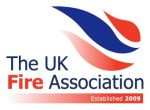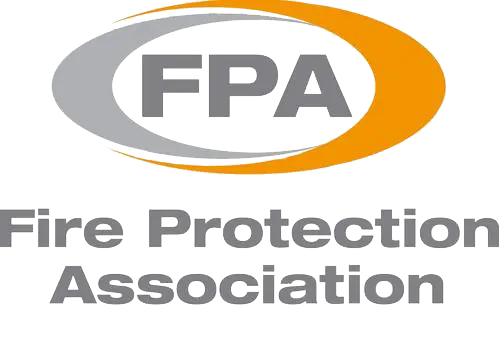When you walk into any building in Guildford, Surrey, or across the South East, you’re surrounded by fire safety systems working hard to protect you – most of which you probably don’t even notice.
Fire protection systems fall into two main categories: active fire protection and passive fire protection.
Both are essential for comprehensive fire safety in Surrey buildings, so let’s explore how they work and why properties in Guildford and the surrounding areas need both.
Active Fire Protection Systems: Your First Line of Defense
Active fire protection systems are the ones that spring into action when danger strikes. These fire suppression systems, detection systems, and emergency equipment require some form of activation – either automatic or manual – to do their job.
Active fire protection requires action to be taken to detect and alert, stop or contain a fire. This may involve a person taking a manual action, such as using a portable fire extinguisher. On the other hand, this may be a smoke detector that triggers an alarm or automatic sprinkler.
Key Active Fire Protection Examples
Fire Detection and Alarm Systems: These are your building’s early warning system. In commercial premises across Guildford and Surrey, automatic fire alarm systems must be installed and conform to the requirements of British Standard 5839-1. Modern fire alarm systems use smoke detectors, heat detectors, and sometimes flame detectors to spot trouble before it spreads.
Automatic Sprinkler Systems: One of the most effective fire suppression systems available. Water sprinkler and spray systems are widely used in the process industries for protection of storage vessels, process plant, loading installations and warehouses. Contrary to what you see in films, sprinkler heads activate individually based on heat detection, not all at once.
Portable Fire Extinguishers: These manual fire suppression tools are strategically placed throughout buildings. There are various types of fire extinguishers for use on different types of fires. Training is required in order to learn how to use fire extinguishers properly. Different extinguisher types handle different fire classes – water for ordinary combustibles, CO2 for electrical fires, and foam for flammable liquids.
Emergency Lighting Systems: Emergency lighting is required to ensure that people can see their escape route in an emergency event such as a fire. These systems automatically illuminate escape routes when main power fails, ensuring safe evacuation even in smoke-filled conditions.
Fire Suppression Systems: Beyond sprinklers, specialized suppression systems use inert gases, chemical agents, or foam for specific applications like server rooms or industrial facilities.
Passive Fire Protection: The Silent Guardians
While active systems fight fires, passive fire protection systems work differently – they’re built into the structure itself to contain and slow fire spread. The term ‘passive fire protection’ describes structural measures implemented to minimise the risk of fire damage. These fire-resistant building elements don’t need activation; they’re always on duty.
Essential Passive Fire Protection Components
Fire Doors and Fire-Rated Doorsets: These aren’t ordinary doors – they’re engineered to resist fire for specific time periods. About three million new fire doors are bought and installed every year in the UK. If a fire door is closed in a room with a fire, it will prevent the fire from spreading outside of the room before fire services arrive. Fire doors typically provide 30 or 60 minutes of fire resistance (FD30 or FD60 ratings).
Fire Compartmentation: This involves dividing buildings into fire-resistant sections or compartments. An example of compartmentalisation would be the installation of (minimum) 30 minute fire rated barriers separating each distinct area throughout a property. Fire compartmentation uses fire-rated walls, floors, and ceilings to create barriers that prevent fire and smoke spread.
Intumescent Coatings: These are special fire-resistant coatings applied to structural steel and other materials. When intumescent paint is exposed to high levels of heat, such as the heat caused by a fire, it swells and chars. As the paint grows in thickness and produces a char, it becomes an insulating layer of protection. This protects the building’s structural integrity during a fire.
Fire Stopping and Penetration Seals: Every opening in fire-rated walls and floors must be properly sealed. Every penetration that breaks the compartment line must be adequately firestopped to reinstate the required fire rating. This includes sealing around pipes, cables, and ductwork using fire-resistant materials like fire collars, wraps, and sealants.
Fire-Resistant Glazing: Specialized glass systems that maintain their integrity during fires, preventing flame and smoke spread while allowing visibility for evacuation routes.
Why Integrated Fire Protection Systems Matter
Here’s the crucial point: effective fire safety requires both active and passive fire protection working together. You need both an active and passive fire safety system working together to prevent, detect and alert, restrict and potentially suppress a developing fire.
Active fire protection systems provide immediate response and suppression capabilities, but they can malfunction or fail. While active systems can help people evacuate or fight the flames, active or moving parts often mean room for malfunction or error. That’s where passive fire protection becomes essential – these systems don’t rely on power, moving parts, or human intervention.
Together, they create multiple layers of protection: active systems detect and fight fires while passive systems contain and slow fire spread, giving people more time to evacuate safely.
Surrey Fire Safety Regulations and Local Compliance
Fire protection in Surrey follows strict UK regulations and British Standards, with local authorities ensuring compliance across Guildford and surrounding areas. The design of fire fighting systems should conform to specified standards such as BS 5306 Code of practice for extinguishing installation and equipment.
Surrey Fire and Rescue Service works closely with local businesses and property owners to ensure fire safety compliance. For passive fire protection, fire doors must be tested and third-party certificated to BS 476 Part 22 or BS EN 1634 Part 1, or other nationally recognised and approved standard.
Recent legislation has strengthened requirements across Surrey. The Fire Safety (England) Regulations 2022, which came into force on 23 January 2023, has made it a legal requirement for responsible persons of all multi-occupied residential buildings in England with storeys over 11 metres in height to undertake quarterly checks on all fire doors within the common areas of premises.
The Building Safety Act 2022 has also introduced new requirements for building safety cases and the “golden thread” of building information, particularly affecting high-rise residential buildings in Guildford and other Surrey towns.
Fire Risk Assessment and Compliance in Surrey
Every building in Guildford and Surrey needs a comprehensive fire risk assessment to determine the appropriate fire protection measures. This assessment considers factors like building height, occupancy levels, escape routes, and specific fire hazards to determine the right combination of active and passive fire protection systems.
Local fire safety professionals in Surrey can help property owners ensure compliance with regulations. Regular maintenance and inspection of both active and passive fire protection systems is essential for compliance and safety across the region. This includes testing fire alarms, servicing sprinkler systems, checking fire door integrity, and ensuring compartmentation remains intact.
The Bottom Line
Effective fire safety isn’t about choosing between active or passive fire protection – it’s about implementing both systems strategically. Active fire protection systems provide rapid detection and suppression, while passive fire protection systems contain fires and protect escape routes.
Whether you’re a building owner in Guildford, a facilities manager across Surrey, or just curious about fire safety, understanding these two types of protection helps you make informed decisions about fire safety measures. Both systems require regular maintenance and professional installation to ensure they perform when needed most.
For Surrey property owners, working with local fire safety specialists who understand regional requirements and building types can ensure optimal protection. Remember: fire protection systems save lives by giving people time to escape safely and limiting property damage. That’s why Surrey councils and UK regulations take them so seriously, and why every building in Guildford and surrounding areas needs both active and passive fire protection working together.
Professional Fire and Electrical Safety Support
While fire protection systems are crucial, many fire incidents in commercial and residential properties stem from electrical faults. ESI: Electrical Safety Inspections specializes in comprehensive electrical and fire safety solutions for workplaces, rented accommodation, and commercial properties across Surrey and Guildford.
Our qualified team provides electrical installation condition reports (EICRs), PAT testing, emergency lighting testing, and fire safety assessments to ensure your property meets all safety regulations. Whether you need electrical safety certificates for rental properties, workplace compliance checks, fire door inspections or commercial fire safety audits, ESI combines electrical expertise with fire safety knowledge to keep your property and occupants protected.
Contact ESI: Electrical Safety Inspections today to ensure your Surrey property has both robust fire protection systems and safe electrical installations working together for complete peace of mind.
Further Reading and Resources:
- Health and Safety Executive (HSE) – Technical Measures Document: Fire Protection
- Cheshire Fire & Rescue Service – Active and Passive Fire Protection
- FireRite – The Difference Between Active and Passive Fire Protection
- Construction Management – What is Fire Compartmentation?
- UK Fire Service Resources – Fire Doors
- Crossfire – The Importance of Fire Compartmentation
- Ark Fire Protection – Passive Fire Protection Guide











